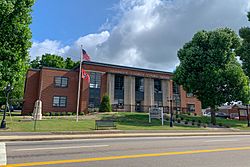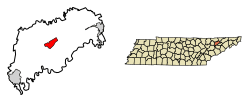Rutledge, Tennessee facts for kids
Quick facts for kids
Rutledge, Tennessee
|
|
|---|---|
| City of Rutledge | |

Grainger County Courthouse in Rutledge
|
|

Location of Rutledge in Grainger County, Tennessee.
|
|
| Country | United States |
| State | Tennessee |
| County | Grainger |
| Incorporated | 1797 |
| Reincorporated | 1955 |
| Named for | George Rutledge |
| Government | |
| • Type | Mayor-aldermen |
| Area | |
| • Total | 5.54 sq mi (14.34 km2) |
| • Land | 5.53 sq mi (14.33 km2) |
| • Water | 0.01 sq mi (0.01 km2) |
| Elevation | 1,017 ft (310 m) |
| Population
(2020)
|
|
| • Total | 1,321 |
| • Density | 238.84/sq mi (92.21/km2) |
| Time zone | UTC-5 (Eastern (EST)) |
| • Summer (DST) | UTC-4 (EDT) |
| ZIP code |
37861
|
| Area code(s) | 865 |
| FIPS code | 47-65820 |
| GNIS feature ID | 1269919 |
Rutledge is a city in Tennessee. It is the main town, or "county seat," of Grainger County. Rutledge is located near both the larger cities of Knoxville and Morristown. In 2020, about 1,321 people lived there.
Contents
History of Rutledge
Rutledge was officially started and became a town in 1797. It was named after General George Rutledge, an important person from nearby Sullivan County. When it became a town, Rutledge was the first place in Grainger County to have its own police department.
In 1801, Rutledge became the official county seat of Grainger County. Before this, several towns had shared this important role. Rutledge grew quickly in the early 1800s because it was located on the Federal Road. This road connected New Orleans all the way to Virginia. The Federal Road crossed another important path, the Wilderness Road, near Bean Station, which is just east of Rutledge.
In the 1820s, Andrew Johnson, who later became a U.S. President, worked as a tailor. He briefly had a tailor shop in Rutledge. In 1976, a copy of his tailor shop was built on the lawn of the Grainger County Courthouse.
During the U.S. Civil War, fighting between small groups made things very difficult in Grainger County. In December 1863, Confederate General James Longstreet passed through Rutledge. He had tried to take Knoxville from Union forces but failed.
On December 14, a battle happened nearby, known as the Battle of Bean's Station. Longstreet attacked Union soldiers who were following him. The Confederates won the battle, but the Union forces were able to get away safely. Longstreet then moved on to Russellville.
In May 1955, the local Lions Club helped Rutledge become a city again. Most people voted for it, with 192 votes in favor and only 21 against. After becoming a city, Rutledge built new systems for sewage and water. This helped the city grow and develop, with money from a program by President Eisenhower.
Geography and Location
Rutledge is in the middle of Richland Valley. This is a narrow valley that stretches for about 35 miles (56 km). It runs along the southern base of Clinch Mountain. Richland Creek flows through most of this valley. It eventually joins the Cherokee Lake part of the Holston River. This is about 20 miles (32 km) downstream from Rutledge.
Rutledge is located where two main roads meet. These are U.S. Route 11W and State Route 92. U.S. Route 11W connects Rutledge to Kingsport to the east and Knoxville to the west. State Route 92 connects the city to Jefferson County and major highways like Interstate 40 and Interstate 81 to the south.
According to the United States Census Bureau, the city covers an area of about 4.7 square miles (12.2 km²). All of this area is land.
People of Rutledge
| Historical population | |||
|---|---|---|---|
| Census | Pop. | %± | |
| 1870 | 107 | — | |
| 1880 | 126 | 17.8% | |
| 1890 | 143 | 13.5% | |
| 1960 | 793 | — | |
| 1970 | 863 | 8.8% | |
| 1980 | 1,058 | 22.6% | |
| 1990 | 903 | −14.7% | |
| 2000 | 1,187 | 31.5% | |
| 2010 | 1,122 | −5.5% | |
| 2020 | 1,321 | 17.7% | |
| Sources: | |||
Rutledge Population in 2020
| Race | Number | Percentage |
|---|---|---|
| White (non-Hispanic) | 1,238 | 93.72% |
| Black or African American (non-Hispanic) | 10 | 0.76% |
| Native American | 3 | 0.23% |
| Asian | 5 | 0.38% |
| Pacific Islander | 1 | 0.08% |
| Other/Mixed | 45 | 3.41% |
| Hispanic or Latino | 19 | 1.44% |
In 2020, the 2020 United States census counted 1,321 people living in Rutledge. There were 611 households and 355 families.
Arts and Culture
Grainger County Tomato Festival
Rutledge Middle School is home to the Grainger County Tomato Festival. This festival celebrates the tomato, which is a very important crop for Grainger County farmers. It has been held every year since 1992.
About thirty thousand people come to the festival. They come from all over Tennessee and the United States. Visitors can learn about the county's history and how important farming is to the state. They can also enjoy live music, buy local produce, and find handmade gifts. There are also arts and crafts activities. The Grainger County Tomato Festival takes place on the last weekend of July.
Historic Places to Visit
- Henderson Chapel African Methodist Episcopal Zion Church
- Nance Building
- Old Grainger County Jail
- William Cocke House
Notable People from Rutledge
- Samuel Bunch (1786–1849), a Congressman and state lawmaker.
- John Alexander Cocke (1772–1854), a Congressman and rival of Andrew Jackson.
- William Michael Cocke (1815–1896), a Congressman and state lawmaker.
- A. W. Davis (1943–2014), an All-American basketball player for the University of Tennessee.
- Robert Taylor Jones (1884–1958), the ninth governor of Arizona, was born in Rutledge.
- James F. Lawrence Jr. (1918–2006), an American Marine Corps hero and lawyer.
- Harold Theodore Tate (1875–1960), the 26th Treasurer of the United States under President Calvin Coolidge.
Images for kids
See also
 In Spanish: Rutledge (Tennessee) para niños
In Spanish: Rutledge (Tennessee) para niños



